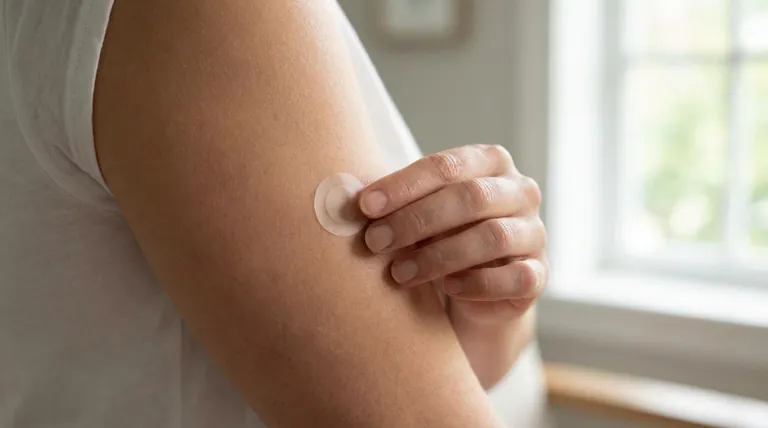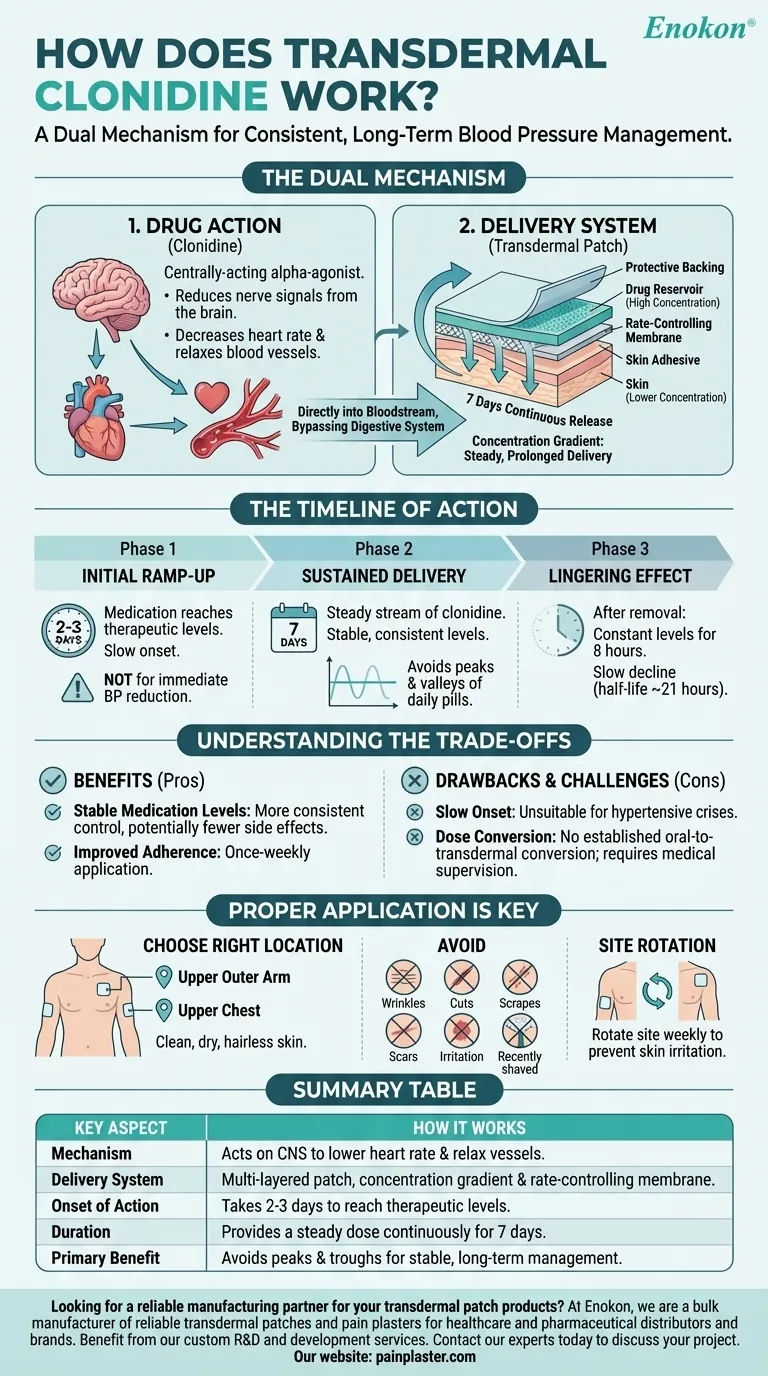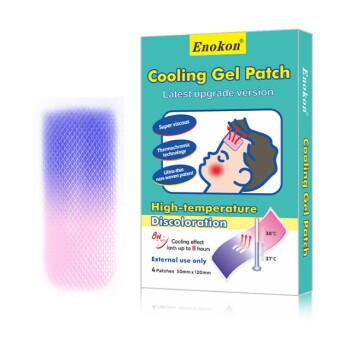At its core, transdermal clonidine works through a dual mechanism. The drug itself, clonidine, acts on the central nervous system to lower heart rate and relax blood vessels. The transdermal patch is a sophisticated delivery system that continuously releases a steady, low dose of this drug through the skin and directly into the bloodstream over seven days.
The key to understanding the clonidine patch is to see it not as a simple bandage with medicine, but as a controlled-release technology. Its primary advantage is bypassing the digestive system to provide a constant, stable level of medication for an entire week, avoiding the daily peaks and valleys of oral pills.

The Dual Mechanism: Drug and Delivery System
To fully grasp how the patch functions, you must understand both what the medication does to the body and how the patch gets it there.
How Clonidine Affects the Body
Clonidine is a centrally-acting alpha-agonist. This means it works in the brain to reduce the nerve signals that tell your heart to beat faster and your blood vessels to tighten.
By calming these signals, clonidine effectively decreases heart rate and relaxes the blood vessels. This allows blood to flow more easily, which in turn lowers blood pressure.
How the Patch Delivers the Drug
The transdermal patch is a multi-layered film engineered for steady, prolonged delivery. It contains several key components: a protective backing, a reservoir holding the drug, a rate-controlling membrane, and a skin adhesive.
The system operates on a simple principle: a concentration gradient. The high concentration of clonidine in the patch's reservoir creates a natural pressure for the drug to move toward the lower concentration in your skin.
The patch's rate-controlling membrane acts as a gatekeeper, ensuring the drug seeps through the skin and into the bloodstream at an approximately constant rate for seven full days.
The Timeline of Action: What to Expect
The transdermal delivery method creates a unique timeline that differs significantly from oral medication.
The Initial Ramp-Up Period
It is critical to understand that the patch does not work instantly. It takes two to three days after applying the first patch for the medication to reach therapeutic levels in your bloodstream.
Sustained, Consistent Delivery
Once therapeutic levels are achieved, the patch provides a steady stream of clonidine for the remainder of its 7-day use. This consistency is a primary benefit for stable, long-term blood pressure management.
The Lingering Effect After Removal
After a patch is removed, clonidine levels in the blood remain constant for about eight hours. Afterward, the drug level slowly declines over several days, with a half-life of approximately 21 hours.
Understanding the Trade-offs and Considerations
While effective, the transdermal system has specific characteristics that make it suitable for some situations but not others.
Benefit: Stable Medication Levels
The greatest advantage of the patch is its ability to avoid the peaks and troughs associated with daily pills. This can lead to more consistent blood pressure control and potentially fewer side effects.
Drawback: Slow Onset of Action
The 2-3 day lag time means the patch is entirely unsuitable for treating a hypertensive crisis or any situation requiring rapid blood pressure reduction.
Challenge: Dose Conversion
There is no established oral-to-transdermal dose conversion. Switching from clonidine pills to the patch requires careful medical supervision and close blood pressure monitoring to find the correct dosage.
Proper Application is Key to Effectiveness
The performance of the patch is directly tied to how it is applied. Following instructions carefully ensures you receive the correct, consistent dose.
Choosing the Right Location
The patch should be applied to a clean, dry, and hairless area of skin on the upper outer arm or upper chest.
What to Avoid
Do not apply the patch to skin that has wrinkles, folds, cuts, scrapes, scars, or irritation. Avoid applying it to an area you have recently shaved.
The Importance of Site Rotation
When you apply a new patch each week, choose a different spot from the previous one. Rotating the application site helps prevent skin irritation from the adhesive.
Making the Right Choice for Your Goal
- If your primary focus is consistent, long-term blood pressure control: The patch's steady, week-long delivery offers a significant advantage for stable management.
- If you struggle with remembering to take daily medication: The once-weekly application can dramatically improve adherence and overall treatment success.
- If you need immediate or rapid blood pressure reduction: The patch is not the correct tool due to its slow, 2-3 day onset of action.
By understanding how this technology works, you can have a more informed discussion with your healthcare provider about achieving your specific health goals.
Summary Table:
| Key Aspect | How it Works |
|---|---|
| Mechanism | Acts on the central nervous system to lower heart rate and relax blood vessels. |
| Delivery System | Multi-layered patch uses a concentration gradient and rate-controlling membrane. |
| Onset of Action | Takes 2-3 days to reach therapeutic levels in the bloodstream. |
| Duration | Provides a steady dose of medication continuously for 7 days. |
| Primary Benefit | Avoids the peaks and troughs of oral medication for stable, long-term management. |
Looking for a reliable manufacturing partner for your transdermal patch products?
At Enokon, we are a bulk manufacturer of reliable transdermal patches and pain plasters for healthcare and pharmaceutical distributors and brands. Our technical expertise ensures high-quality, consistent delivery systems for products like the clonidine patch.
Benefit from our custom R&D and development services to create effective transdermal solutions for your patients.
Contact our experts today to discuss your project requirements and how we can support your brand's success.
Visual Guide

Related Products
- Asthma Cough and Pain Relief Patch for Adults and Kids
- Far Infrared Deep Heat Relief Patches Medicated Pain Relief Patches
- Herbal Eye Protection Patch Eye Patch
- Mugwort Wormwood Pain Relief Patch for Neck Pain
- Menthol Gel Pain Relief Patch
People Also Ask
- Can pregnant women use pain relief patches? Your Essential Guide to Safe Pain Management
- What types of coughs can the far infrared cough relief patch address? Soothe Dry, Wet, and Persistent Coughs
- What role do natural ingredients and acupoint stimulation play in a cough relief patch? Synergistic Relief Explained
- How does capsaicin work in the Reliever Patch? A Drug-Free Solution for Targeted Pain Relief
- How does the far infrared technology in the cough relief patch work? Enhance Natural Ingredient Delivery














